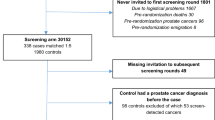Abstract
Background
Prior to introduction of the prostate-specific antigen (PSA) test, the Seattle–Puget Sound and Connecticut Surveillance, Epidemiology and End Results (SEER) areas had similar prostate cancer mortality rates. Early in the PSA era (1987–1990), men in the Seattle area were screened and treated more intensively for prostate cancer than men in Connecticut.
Objective
We previously reported more intensive screening and treatment early in the PSA era did not lower prostate cancer mortality through 11 years and now extend follow-up to 15 years.
Design
Natural experiment comparing two fixed population-based cohorts.
Subjects
Male Medicare beneficiaries ages 65–79 from the Seattle (N = 94,900) and Connecticut (N = 120,621) SEER areas, followed from 1987–2001.
Measurements
Rates of prostate cancer screening; treatment with radical prostatectomy, external beam radiotherapy, and androgen deprivation therapy; and prostate cancer-specific mortality.
Main Results
The 15-year cumulative incidences of radical prostatectomy and radiotherapy through 2001 were 2.84% and 6.02%, respectively, for Seattle cohort members, compared to 0.56% and 5.07% for Connecticut cohort members (odds ratio 5.20, 95% confidence interval 3.22 to 8.42 for surgery and odds ratio 1.24, 95% confidence interval 0.98 to 1.58 for radiation). The cumulative incidence of androgen deprivation therapy from 1991–2001 was 4.78% for Seattle compared to 6.13% for Connecticut (odds ratio 0.77, 95% confidence interval 0.67 to 0.87). The adjusted rate ratio of prostate cancer mortality through 2001 was 1.02 (95% C.I. 0.96 to 1.09) in Seattle versus Connecticut.
Conclusion
Among men aged 65 or older, more intensive prostate cancer screening early in the PSA era and more intensive treatment particularly with radical prostatectomy over 15 years of follow-up were not associated with lower prostate cancer-specific mortality.


Similar content being viewed by others
References
Ries L, Harkins D, Krapcho M, et al. SEER Cancer Statistics Review, 1975–2003. Bethesda, MD: National Cancer Institute; ; 2006.
Hankey B, Feuer E, Clegg L, et al. Cancer surveillance series: Interpreting trends in prostate cancer - Part I: Evidence of the effects of screening in recent prostate cancer incidence, mortality, and survival rates. J Natl Cancer Inst. 1999;91:1017–24.
Feuer E, Merrill R, Hankey B. Cancer surveillance series: Interpreting trends in prostate cancer - Part II: Cause of death misclassification and the recent rise and fall in prostate cancer mortality. J Natl Cancer Inst. 1999;91:1025–32.
Etzioni R, Penson DF, Legler JM, et al. Overdiagnosis due to prostate-specific antigen screening: lessons from U.S. prostate cancer incidence trends. J Natl Cancer Inst. 2002;94:981–90.
Shaw P, Etzioni R, Zeliadt S, et al. An ecologic study of prostate-specific antigen screening and prostate cancer mortality in nine geographic areas of the United States. Am J Epidemiol. 2004;160:1059–69.
Potosky A, Feuer E, Levin D. Impact of screening on incidence and mortality of prostate cancer in the United States. Epidemiologic Reviews. 2001;23:181–6.
Albertsen P. The prostate cancer conundrum. J Natl Cancer Inst. 2003;95:930–1.
Damber J. Decreasing mortality rates for prostate cancer: possible role of hormonal therapy. BJU International. 2004;93:695–701.
Lu-Yao G, Albertsen PC, Stanford JL, Stukel TA, Walker-Corkery ES, Barry MJ. Natural experiment examining impact of aggressive screening and treatment on prostate cancer mortality in two fixed cohorts from Seattle area and Connecticut. BMJ. 2002;325:740–5.
Smith R, Cokkinides V, Eyre H. American Cancer Society guidelines for the early detection of cancer, 2006. CA Cancer J Clin. 2006;56:11–25.
Oleynick JU, Albertsen PC, Barry MJ, Walker-Corkery ES, Yao SL, Lu-Yao GL. Utility of the SEER-Medicare data to identify medical androgen deprivation therapy. J Clin Onc. 2006;24:6113.
Warren JL, Klabunde CN, Schrag D, Bach PB, Riley GF. Overview of the SEER-Medicare data: content, research applications, and generalizability to the United States elderly population. Medical Care. 2002;40:IV–3–18.
McCullagh P, Nelder J. Generalized Linear Models. London: Chapman and Hall; 1989.
Cox DR. Regression models and life-tables. Journal of the Royal Statistical Society, Series B, Methodological. 1972;34:187–220.
D’Agostino R, Lee M, Belanger A. Relation of pooled logistic regression to time dependent Cox regression analysis: the Framingham Heart Study. Statistics in Medicine. 1990;9:1501–15.
Concato J, Wells CK, Horwitz RI, et al. The Effectiveness of screening for prostate cancer: A nested case-control study. Arch Intern Med. 2006;166:38–43.
Oberaigner W, Horninger W, Klocker H, Schonitzer D, Stuhlinger W, Bartsch G. Reduction of prostate cancer mortality in Tyrol, Austria, after introduction of prostate-specific antigen testing. Am J Epidemiol. 2006;164:376–84.
Wong Y, Mitra N, Hudes G, et al. Survival associated with treatment vs observation of localized prostate cancer in elderly men. JAMA. 2006;296:2683–93.
Lu-Yao G, Greenberg ER. Changes in prostate cancer incidence and treatment in the USA. Lancet. 1994;343:251–4.
Newschaffer CJ, Otani K, McDonald MK, Penberthy LT. Causes of death in elderly prostate cancer patients and in a comparison nonprostate cancer cohort. J Natl Cancer Inst. 2000;92:613–.
Bill-Axelson A, Holmberg L, Ruutu M, et al. Radical prostatectomy versus watchful waiting in early prostate cancer. N Engl J Med. 2005;352:1977–84.
Acknowledgement
This research was funded by grants from the Agency for Health Care Research and Quality (HS 08397, HS 10278).
Conflict of Interest Statement
None disclosed.
Author information
Authors and Affiliations
Corresponding author
Rights and permissions
About this article
Cite this article
Lu-Yao, G., Albertsen, P.C., Stanford, J.L. et al. Screening, Treatment, and Prostate Cancer Mortality in the Seattle Area and Connecticut: Fifteen-year Follow-up. J GEN INTERN MED 23, 1809–1814 (2008). https://doi.org/10.1007/s11606-008-0785-8
Received:
Revised:
Accepted:
Published:
Issue Date:
DOI: https://doi.org/10.1007/s11606-008-0785-8




